This shellfishing operation is helping our waters thrive.
I step out onto the beach, and the familiar southwest winds running down the length of Lagoon Pond welcome me. Though I have spent many afternoons on these waters with my high school sailing team, I was barely aware of the flourishing shellfish farms a short distance from where we typically launch our boats — until I was invited to see one for myself.
I look behind me to see oyster farmer Noah Mayrand making his way down to the beach. He helps me onto his skiff, and we depart the dock. I have no idea what it takes to grow shellfish, but I’m eager to find out.
Noah grew up on the Island and has been connected to the ocean and sea life for as long as he can remember. “I spent so many hours on the jetties,” he tells me. “That was my babysitter — playing around, fishing, snorkeling.” Mayrand’s father, a plumber, would barter his services with fishermen who would take Noah and his father on chartered fishing trips to catch striped bass. Noah was only four or five when he began fishing, but he quickly became addicted. His mom often took him to Tashmoo Beach where he’d climb the jetties with his friends and scrape seaweed off the side of rocks or find small shrimp. He tells me matter-of-factly, “We would eat it. That’s where I gained a taste for ocean.”
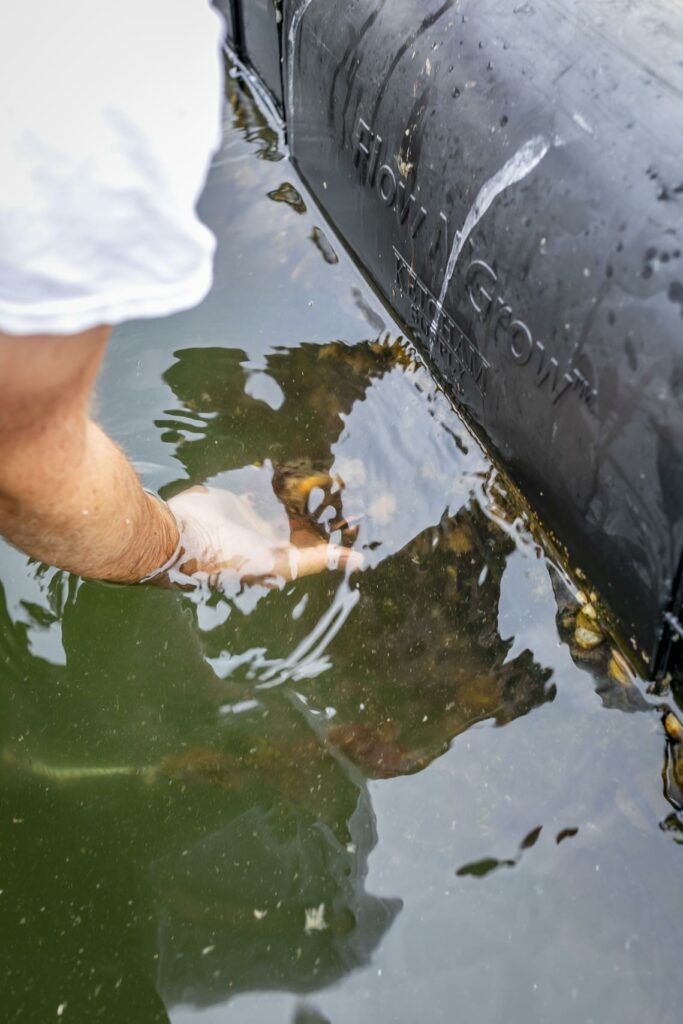
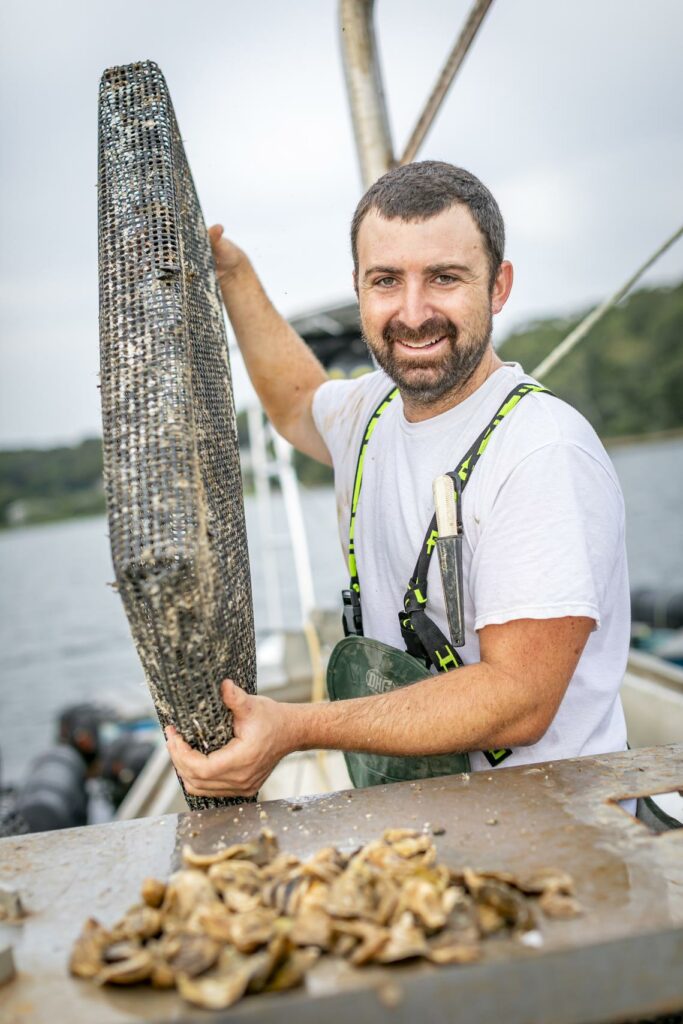
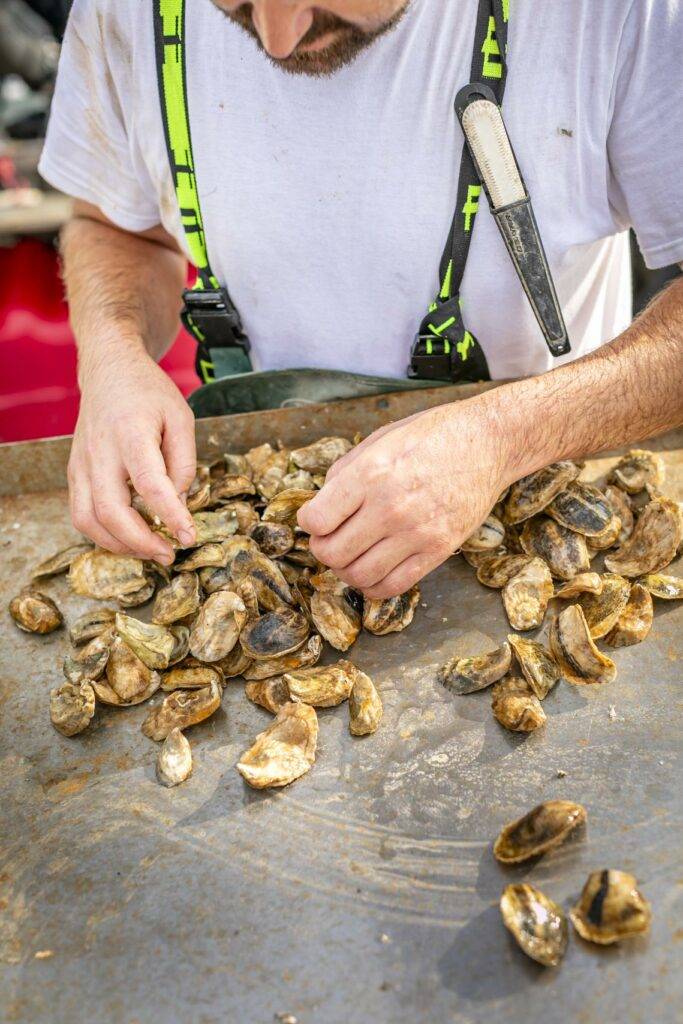
He knew he wanted to keep this early, deep connection to the sea for the rest of his life. He learned to sail at Sail MV; later, he learned to build sailboats during a high school internship at the Five-Corners boatyard with the Charter School. Both of these experiences, he believes, helped prepare him to be an oyster farmer. “My workshop was the boatyard,” he says. “That’s kinda why I know how to build rafts.”
I spot a ten- by fifteen-foot wooden raft surrounded by a dozen buoys — Noah’s oyster farm. Each buoy marks a submerged oyster cage lying twenty feet deep on the lagoon floor. He docks his skiff and helps me onto the raft.
I want to know what has kept him motivated in the risky aquaculture business. How does someone decide to become an oyster farmer? For Noah, it stemmed from his career as a cook.
Though he studied art at the School of the Museum of Fine Arts, Noah found himself drawn to cooking after he got out of college. The farm-to-table movement was taking off in California, and he wanted to be a part of it. Seeking a change from the Island, he left for San Francisco, where he experienced “life-changing meals.” He found a job at a restaurant called Beast and the Hare, where he learned the art of butchery. “It became, ‘how do we butcher it and how do we make a menu out of this,’” he tells me — as opposed to, “What can we make and where are we going to get it?” They used the whole animal, nose to tail, and built the menu around it.
Later he got a job at a big technology company in San Francisco, working as a corporate sous chef. While he often made sandwiches for interns, he also got to work upscale dinners for CEOs and other private events. He had the budget to buy quality food, and he did just that.
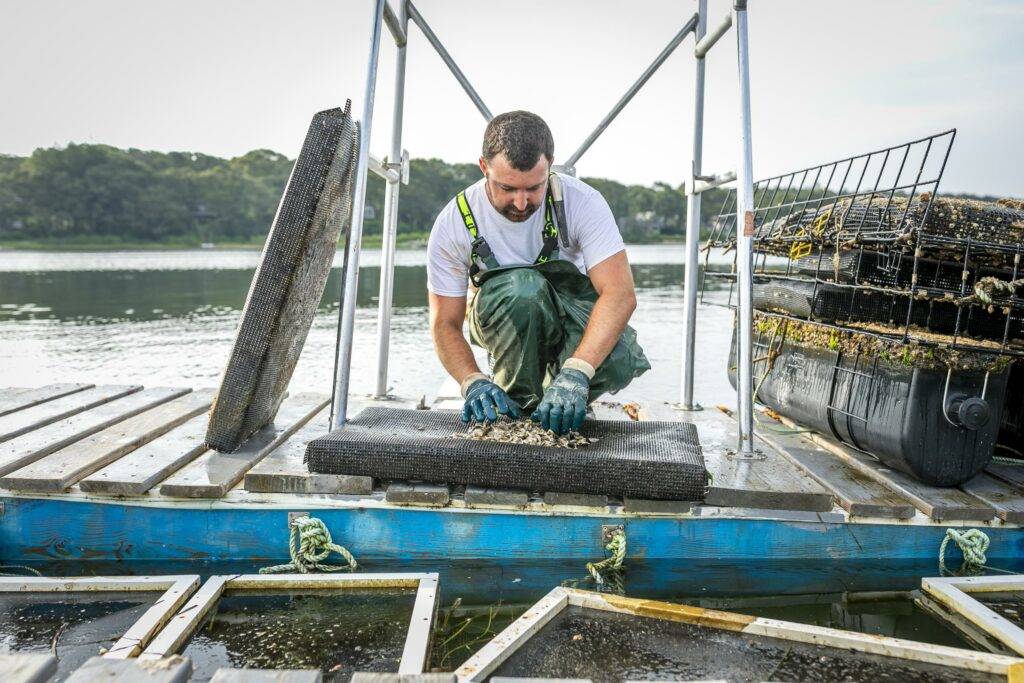
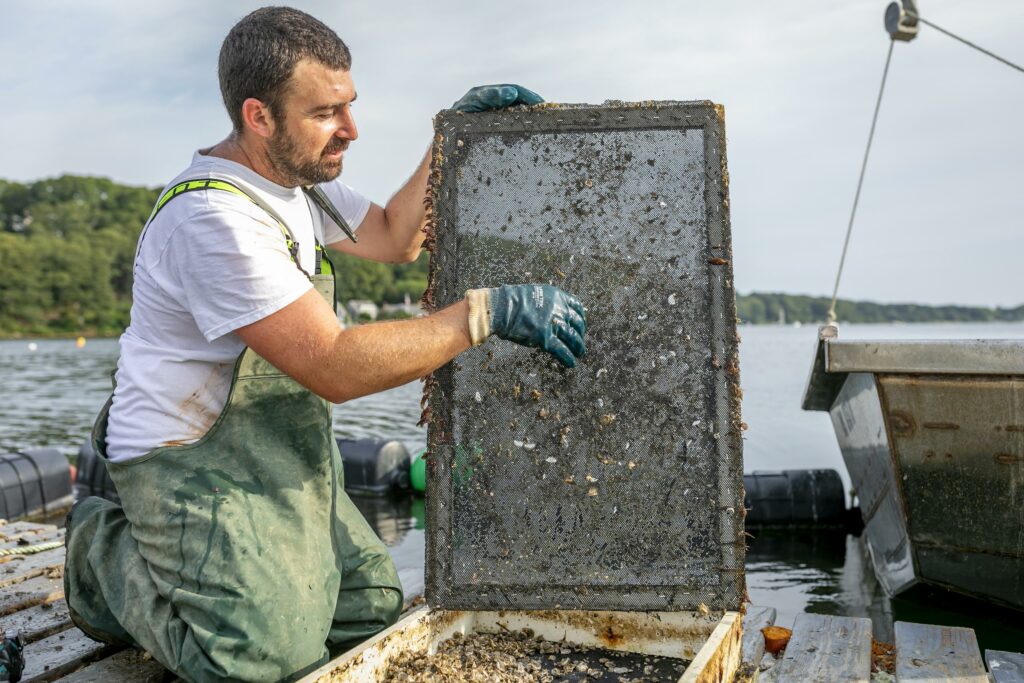

Noah how to break down whole animals — pigs, lambs, goats, sheep. “We would go to cow farms and purchase a live cow,” he tells me. “They would be killed later in the season and then I’d butcher them.” Because he’d worked so closely with the farmers, he grew to appreciate the quality of local food. “I found this product was so far better than something that was sitting [in stores].” He adds, “The speed with which I could bring it to these people made it fresher — it just sat in that many fewer refrigerators.”
After almost four years, he was ready for a change. “I was always talking about home. I was always saying ‘my island, my island.’” When he inherited some land on the Vineyard, he decided to return home. At the same time, he realized that he didn’t want to just cook fresh food; he wanted to grow it. He wanted to become a farmer — any kind of farmer. “I just needed a place to grow things,” he said.
Seeing the ocean as an extension of the Island, and noticing the growing aquaculture business on the Island, he did some research. Beyond the “how-tos,” he learned about oysters’ ability to clean ocean water while capturing carbon, combatting some of the effects of climate change. This sealed the deal for him: He would grow oysters.
He hit a snag when he discovered that there was no process to obtain a permit for aquaculture in Tisbury, his town of residence. Undaunted, he went to his first town select board meeting in February 2015 and told the town “I wanna start an oyster farm. How do I do this?” At the board’s suggestion, he attended some shellfish board meetings, and along the way found others who also wanted to create aquaculture regulations in Tisbury that would allow for permitting down the road. It took years of hard work to get aquaculture regulations finally passed.
In the meantime, he set about learning the oyster farming trade by working as a farmhand with shellfish companies in Katama. His employers knew he wanted to start his own farm in Tisbury; they supported him and ensured, during his “four years of oyster college,” that he acquired all the know-how he’d need.
For his part, Noah hoped the regulations in Tisbury could reflect what he’d seen in practice in Katama. It had worked for 25 years, he figured, so it seemed like a good model. But “I didn’t feel like I was being heard,” he tells me, and it was difficult to get the community to reach an agreement. Finally, after four years, in November 2019, Noah became the first oyster farmer to secure an aquaculture permit in Vineyard Haven. He was relieved and happy — and ready to get started.
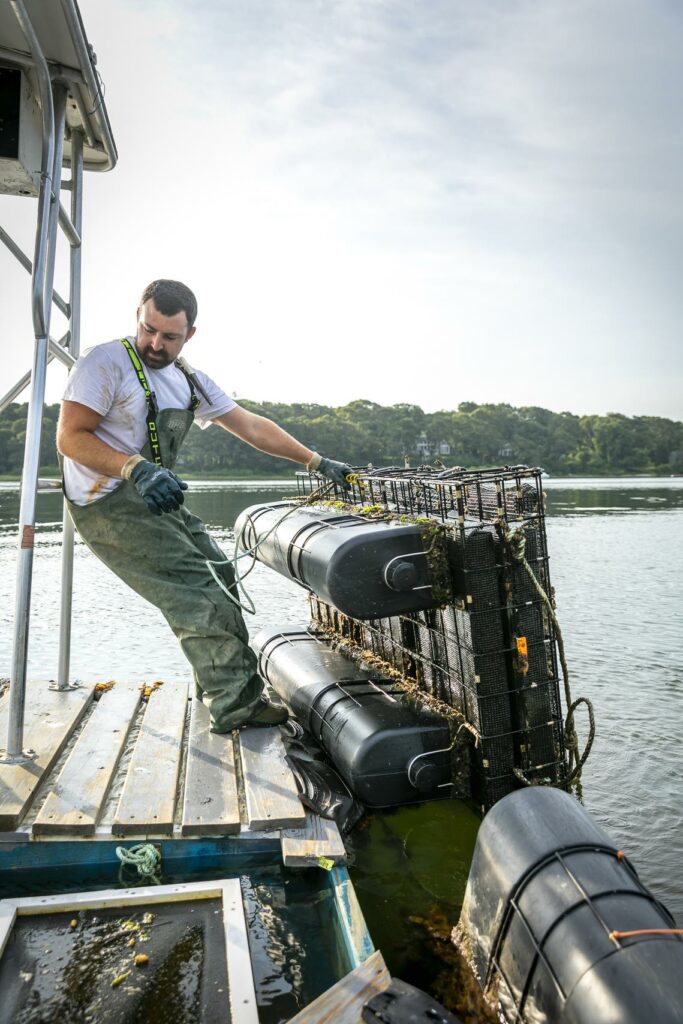
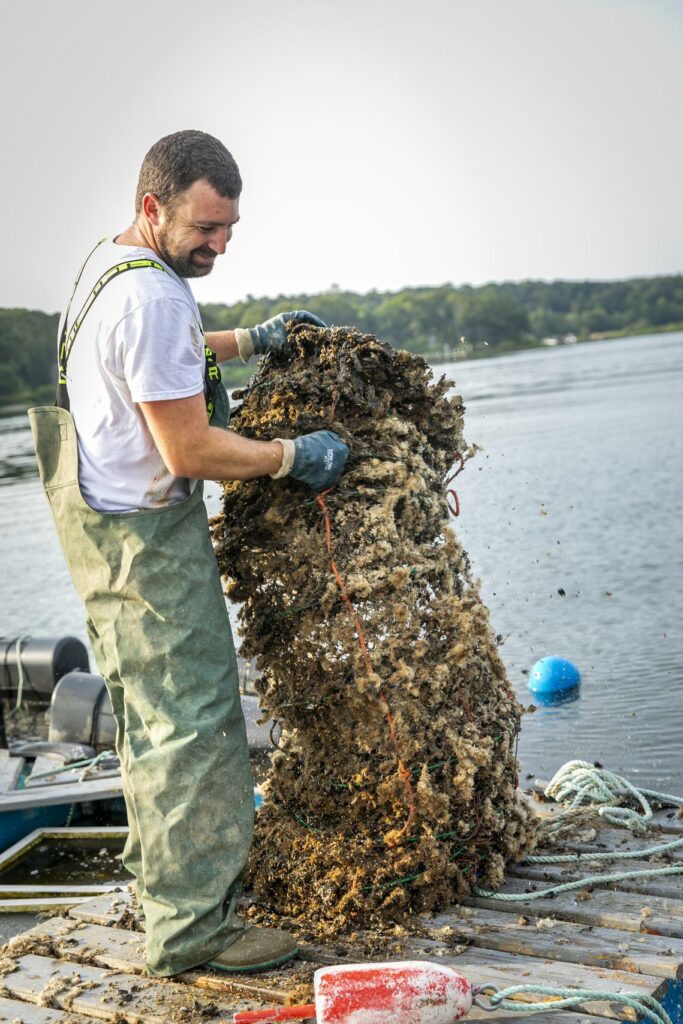
Through it all, Noah found motivation in other people’s doubt; he knew he could prove them wrong. “When they say you can’t,” he says, “you absolutely will.” Now, working as his own boss, he finds that what keeps him going is his commitment to respecting nature and being a role model in his community. “I wanna be that different fisherman that gives more than they take,” he says.
As Noah looks back on when he first anchored in Lagoon Pond, he is amazed by the diversity of species that have become a part of his farm. He was determined to grow oysters to benefit the waters, so he was happy to find new species of seaweed, mussels, and fish benefitting from his farm. His farm has built the foundation for a new ecosystem. Daily, he sees more and more fish feeding off an environment he contributed to. “It brings me back to my childhood,” he says, “where I saw [nature] as plentiful and diverse.”
Want to learn more? Check out our story on the Martha’s Vineyard Shellfish Group.
Print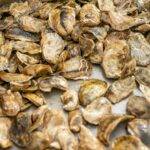
Grilled Oysters with Sweet Butter and Classic French Mignonette
- Yield: Makes 36 oysters 1x
Ingredients
- 36 fresh oysters, shucked
For the mignonette:
- 1 cup red wine vinegar
- 1/2 teaspoon raw sugar
- 2–3 finely chopped shallots
- 1/4 cup chopped fresh parsley
- Lots of fresh cracked black pepper (6 turns of a pepper mill)
For the butter:
- 1 stick of butter at room temperature
- 1/4 cup honey or agave syrup
- Zest of 1 orange
- Pinch of salt
Instructions
- In a small bowl, mix together the ingredients for the mignonette and set aside.
- In a separate bowl, whip the butter with the honey, orange zest, and salt. Top each shucked oyster with a generous ½ teaspoon of the butter mixture, then place the oysters on a hot grill and cook until the butter has melted and the oysters start bubbling, about 3 minutes.
- Spoon a little of the mignonette onto each cooked oyster, and serve.

